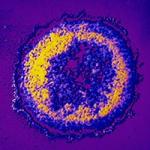
Research Topics
The Molecular Signaling Section studies basic principles and clinical correlates of leukocyte chemoattractants and their G protein-coupled receptors. The chemoattractants under study include a large family of chemokines and a smaller group of classical chemoattractants, which together differentially regulate specific leukocyte trafficking in support of both immune homeostasis and innate and adaptive immune responses. The scope of research includes basic investigation of chemoattractant signaling and leukocyte trafficking, the role of chemoattractants in immunoregulation in both homeostatic and disease conditions, and clinical correlates of chemoattractant action. Pathogens under study include SARS-CoV-2, E. coli, Trypanosoma cruzi and Toxoplasma gondi. The clinical program investigates inborn errors of immunity, including WHIM syndrome, G6PC3 deficiency, and SASH3 deficiency and is developing new drug treatments, as well as gene therapy and allotransplantation cure strategies for affected patients. Mouse models of infection and immunodeficiency disease are used to dissect mechanisms of pathogenesis and for preclinical trials of novel interventions.
Major discoveries of the Molecular Signaling Section include the following:
- Discovery of the first CXC, CC, and CX3C chemokine receptor subtypes, as well as other members of the chemokine receptor family, and characterization of their ligand and leukocyte specificities
- Characterization of the f-Met-Leu-Phe receptor (FPR) family
- Discovery of CCR5 and delineation of both its chemokine receptor and HIV coreceptor activities; discovery of the HIV/AIDS genetic restriction factor CCR5Δ32
- Discovery of the first virally-encoded chemokine receptors, ECRF3 of Herpesvirus saimiri and US28 of Human Cytomegalovirus
- Discovery of genetic risk factors in patients with atherosclerosis, HIV/AIDS, West Nile virus infection, and kidney transplant rejection
- Discovery of a subtype of G6PC3 deficiency, a rare primary immunodeficiency disease characterized by severe congenital neutropenia due to defects in glucose metabolism that predispose to recurrent bacterial infection
- Development of the CXCR4 antagonist plerixafor as targeted therapy in the combined primary immunodeficiency disorder WHIM syndrome
- Discovery of anionic phospholipids as the third class of chemokine binding factors (the other two being G protein-coupled receptors and glycosaminoglycans); discovery of chemokine binding to phosphatidyl serine as a find-me signal in apoptotic cell clearance and chemokine binding to cardiolipin as a key mechanism responsible for direct chemokine antimicrobial activity
- Discovery of anti CD117-saporin immunotoxin as a safe conditioning method for establishment of high-level hematopoietic chimerism and donor-specific tolerance in a complete immunologically mismatched mouse model of bone marrow allotransplantation
- Discovery of spontaneous chromothriptic cure of WHIM syndrome in a patient by deletion of the disease allele of CXCR4, but not the wild type CXCR4 allele, in a single hematopoietic stem cell
There are projects ongoing in the lab extending each of these observations.
Biography
Dr. Murphy obtained an A.B. from Princeton University in 1975 and an M.D. from Cornell University Medical College in 1981. He trained in internal medicine at New York University from 1981 to 1985, serving as chief resident from 1984 to 1985, and in infectious diseases at NIAID from 1985 to 1988.
He began his research career as a medical staff fellow in the Bacterial Diseases Section of the NIAID Laboratory of Clinical Investigation in 1986 and was promoted to senior investigator with tenure in the Laboratory of Host Defenses (LHD) in 1992. In 1998, he was promoted to the Senior Biomedical Research Service and named chief of the LHD Molecular Signaling Section.
In 2003, Dr. Murphy's research group was reorganized as part of the new Laboratory of Molecular Immunology, where he served first as acting chief from 2003 to 2006 and then as chief from 2006 to the present. Dr. Murphy's research interests include immunoregulation by chemokines and related chemoattractants, infectious disease pathogenesis, and inborn errors of immunity.
Memberships
- American Association for the Advancement of Science
- American Society for Clinical Investigation
- Association of American Physicians
- American Association of Immunologists
- Society for Leukocyte Biology
- The Henry Kunkel Society
- American Academy of Microbiology
Editorial Boards
- Journal of Leukocyte Biology
- Viral Immunology
- Journal of Innate Immunity
Selected Publications
- Pontejo SM, Murphy PM. Chemokines act as phosphatidylserine-bound "find-me" signals in apoptotic cell clearance. PLoS Biol. 2021;19(5):e3001259.
- Gao JL, Owusu-Ansah A, Yang A, Yim E, McDermott DH, Jacobs P, Majumdar S, Choi U, Sweeney CL, Malech HL, Murphy PM. CRISPR/Cas9-mediated Cxcr4 disease allele inactivation for gene therapy in a mouse model of WHIM syndrome. Blood. 2023;142(1):23-32.
- Li Z, Czechowicz A, Scheck A, Rossi DJ, Murphy PM. Hematopoietic chimerism and donor-specific skin allograft tolerance after non-genotoxic CD117 antibody-drug-conjugate conditioning in MHC-mismatched allotransplantation. Nat Commun. 2019;10(1):616.
- McDermott DH, Gao JL, Liu Q, Siwicki M, Martens C, Jacobs P, Velez D, Yim E, Bryke CR, Hsu N, Dai Z, Marquesen MM, Stregevsky E, Kwatemaa N, Theobald N, Long Priel DA, Pittaluga S, Raffeld MA, Calvo KR, Maric I, Desmond R, Holmes KL, Kuhns DB, Balabanian K, Bachelerie F, Porcella SF, Malech HL, Murphy PM. Chromothriptic cure of WHIM syndrome. Cell. 2015;160(4):686-699.
- McDermott DH, Velez D, Cho E, Cowen EW, DiGiovanna JJ, Pastrana DV, Buck CB, Calvo KR, Gardner PJ, Rosenzweig SD, Stratton P, Merideth MA, Kim HJ, Brewer C, Katz JD, Kuhns DB, Malech HL, Follmann D, Fay MP, Murphy PM. A phase III randomized crossover trial of plerixafor versus G-CSF for treatment of WHIM syndrome. J Clin Invest. 2023;133(19).
Related Scientific Focus Areas


Microbiology and Infectious Diseases
View additional Principal Investigators in Microbiology and Infectious Diseases
This page was last updated on Monday, March 25, 2024